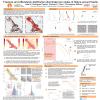Poster #144, Fault and Rupture Mechanics (FARM)
Two timescales of fault stabilization by dilatant hardening: slow slip events followed by prolonged dynamic rupture
Poster Image:

Poster Presentation
2020 SCEC Annual Meeting, Poster #144, SCEC Contribution #10709 VIEW PDF
Triaxial compression experiments were conducted on Fontainebleau sandstone with initial porosities of 4, 6, and 14% at a constant effective pressure of 70 MPa (produced by various combinations of confining and pore pressures) and strain rates of 10-6 to 10-4 /s, along with bulk permeability measurements. Here we report two timescales of fault stabilization by dilatant hardening: long-term stabilization over the entire failure events, and short-term stabilization during the unstable part of failure. (1) 14% porosity samples deformed at all Pc and Pf, and 4-6% porosity samples deformed at low Pc and Pf, show entirely unstable failure. In contrast, 4-6% porosity samples deformed at high Pc and Pf fail slowly over 10-100 seconds, followed by minor unstable failure. The observed stabilization is consistent with that expected from the drainage conditions constrained from bulk permeabilities and far-field strain rates. The timescales of failure observed over a range of strain rates show a unique scaling relationship with the timescale of characteristic strain for a given strain rate: tfailure ~ tdef n. Fully unstable failure shows n ~ 1, while stabilized failure exhibits n ~ 0.07, smaller than n ~ 1/3 predicted from theoretical models of dilatant hardening. (2) In addition, stabilization also occurs during the unstable part of failure. 4-6% porosity samples deformed at high Pc and Pf display prolonged unstable failure (~1 second based on 0.1 MHz strain gage data) along with tremor-like seismicity. In contrast, experiments showing fully unstable failure are marked by distinct, <10 millisecond earthquake-like seismicity. The timescales of prolonged unstable failure show little correlation with imposed strain rates. Thus, our results suggest that, for the long-term stabilization, dilatant hardening is governed by bulk fluid diffusion and far-field strain rate, but, for the short-term stabilization, by much shorter timescales of deformation (e.g., dynamic rupture).























































